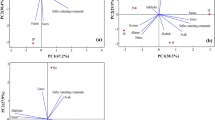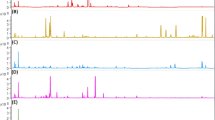Abstract
Saffron spice is valuable for its colour, taste and aroma. All these properties depend on the different postharvesting treatments that Crocus sativus L. stigmas received to convert it into a spice. No previous scientific data relate the volatile content with its postharvesting process or origin. In this paper, two different analytical methods are used, CG-MS to determine volatile markers and an electronic nose based on metal oxides to determine the volatile profile of the samples from different geographic origins. It is demonstrated by means of CG-MS that 3,5,5-trimethyl-2-cyclohexenone, 2,6,6-trimethylcyclohexane-1,4-dione and acetic acid are capable to differentiate saffron from its origin. The content of acetic acid is very high in samples from Iran or Morocco, while low or undetectable content was observed in Greek and Spanish samples. In turn, using an e-nose (specifically optimised for this particular application), samples from different countries could be discriminated using Principal Component Analysis with a 90% of confidence.




Similar content being viewed by others
References
Ait-Oubahou A, El-Otmani M (1999) Saffron Crocus sativus L. Medicinal and aromatic plants. Industrial profiles. In: Negbi M (ed). Harwood Academic Publishers, Amsterdam, Holland, pp 87–102
Hassnain FM (1998) Saffron cultivation in Kashmit. In: Sethi SS (ed). Rima Publishing House, Nueva Delhi, India
Nauriyal JP, Gupta R, George CK (1997) Arecaunt Spices Bull 8:59–72
Goliaris AH (1999) Saffron Crocus sativus L. Medicinal and aromatic plants. Industrial profiles. In: Negbi M (ed). Harwood Academic Publishers, Amsterdam, Holland, pp 73–87
Ordoudi S, Tsimidou M (2004) In: Dris R, Jain SM (eds). Kluwer Academic Publishers, Dordrecht, The Netherlands, pp 209–260
Carmona M, Zalacain A, Pardo JE, López E, Alvarruiz A, Alonso GL (2005) J Agric Food Chem 53:3974–3979
Cadwallader KR, Baek HH, Cai M (1997) In: Riach SJ, Ho CT (eds). American Chemical Society Symposium Series 660, Washington, DC, pp 66–79
Cadwallader KR (2002) In: Winterhalter P, Rouseff R (eds). American Chemical Society Symposium Series 802, Washington, DC, pp 220–239
D'Auria M, Mauriello G, Rana GL (2004) Flavour Fragrance J 19:7–23
Kanakis CD, Daferera J, Tarantilis PA, Polissiou MG (2004) J Agric Food Chem 52:4515–4521
Rödel W, Petrizka M (1991) J High Res Chromatogr 14:771–774
Tarantilis PA, Polissiou MG (1997) J Agric Food Chem 45:459–462
Zareena AV, Variyar PS, Gholap AS, Bongirwar DR, Wani AM (2001) J Agric Food Chem 49:687–691
Zarghami NS, Heinz DE (1971) Lebensm Wissen Techn 4:43–45
Zarghami NS, Heinz DE (1971) Phytochemistry 10:2755–2761
Alonso GL, Salinas MR, Garijo J (1998) J Food Prot 61:1525–1528
Alonso GL, Salinas MR, Sánchez MA, Garijo J (2001) Food Sci Tech Int 7:225–229
Bartlett PN, Blair N, Gardner JW (1997) Food Technol 51:44–48
Gardner JW, Bartlett PN (1999) Electronic noses. Oxford University Press, Oxford
Di Natale C, Davide FAM, D'Amico A, Nelli P, Groppelli S, Sberveglieri G (1996) Sens Actuators B 33:83–88
Pearce TC, Schiffman SS, Nagle HT, Gardner JW (eds) (2002) Handbook of machine olfaction: Electronic nose technology, Chap 7, Wiley-VCH, Weinheim, Germany
Di Natale C, Macagnano A, Davide F, D'Amico A, Paolesse R, Boschi T, Faccio M, Ferri G (1997) Sens Actuators B 44:521–526
Orts J, Llobet E, Vilanova X, Brezmes J, Correig X (1999) Sens Actuators B 60:106–117
Schaller E, Zenhäusern S, Zesiger T, Bosset JO, Escher F (2000) Analysis 28:743–749
Semiond D, Dautraix S, Desage M, Majdalani R, Casabianca H, Brazier JL (1996) Anal Lett 6(29):1027–1039
Knapp H, Straubinger M, Witte A, Winterhalter P (2000) In: Schieberle P, Engel KH (eds) Proceedings of the 9th Weurman flavour research symposium, Garching, Germany, pp 440–444
Author information
Authors and Affiliations
Corresponding author
Rights and permissions
About this article
Cite this article
Carmona, M., Martínez, J., Zalacain, A. et al. Analysis of saffron volatile fraction by TD–GC–MS and e-nose. Eur Food Res Technol 223, 96–101 (2006). https://doi.org/10.1007/s00217-005-0144-5
Received:
Revised:
Accepted:
Published:
Issue Date:
DOI: https://doi.org/10.1007/s00217-005-0144-5




